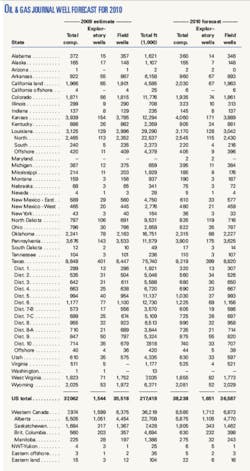The roller coaster drilling year of 2009 gives way to somewhat brighter prospects in the US and Canada in 2010.
US and Canada average rig counts were each down 42% in 2009 compared with 2008 by Baker Hughes figures, and in many parts of the US operators ran fewer than half the rigs on average than they did in 2008.
Still, the US count rebounded from fewer than 900 rigs in early June 2009 to 1,189 as the year ended.
The bright spots in the US in 2009 were in Kansas, dominated by relatively shallow drilling; North Louisiana, center of the Haynesville shale gas play, and Pennsylvania, where the Devonian Marcellus shale gas play added to drilling for even shallower Appalachian formations.
Vast shale gas and oil plays emerging over millions of acres in several states probably kept the rig count from slumping worse than it did in response to the sharply lower oil and gas prices than those that prevailed in the first half of 2008.
Here are highlights of OGJ's early year drilling forecast for 2010:
• Operators will drill 38,238 wells in the US, up from an estimated 37,062 wells in 2009.
• All operators will drill 1,651 exploratory wells of all types, up from an estimated 1,544 last year.
• The Baker Hughes Inc. count of active US rotary rigs will average 1,130 rigs/week this year, up from 1,087 in 2009 and down from 1,867 in 2008, and 1,767 in 2007.
• Operators will drill 8,585 wells in western Canada, up from an estimated 7,974 wells in 2009.
US drilling
The 2009 US rig count averaged 42% below the 2008 level and was the lowest since 2003, when operators averaged 1,030 rigs/week.
First quarter US drilling fell to a level not seen since 2004, marking the end of 6 years of first quarter growth, the American Petroleum Institute estimated.
Chesapeake Energy Corp., Oklahoma City, said it operated 103 rigs drilling for gas in the US in early December 2009. The next busiest US gas drillers, according to the Smith International survey, were ExxonMobil Corp. at 41 rigs, EnCana Corp. at 36 rigs, EOG Resources Inc. at 31 rigs, and Anadarko Petroleum Corp. at 24 rigs.
ExxonMobil buttressed its position in North American unconventional gas with purchase of XTO Energy Inc., and assumption by Newfield Exploration Co. and Anadarko Petroleum of most assets of bankrupt TXCO Resources Inc. could add impetus to the Eagle Ford and Pearsall shales and other South Texas Maverick basin plays in 2010 and beyond.
New York had an average of 2.2 rigs/week in 2009 compared with 6 rigs/week in 2008, and the future is uncertain until the state resolves issues surrounding drilling and hydraulic fracturing in the Marcellus shale (OGJ Online, Dec. 29, 2009).
Appalachian shale gas drilling could spread into Maryland in 2010. Samson Resources Co., private Tulsa operator, sought permits in November 2009 to drill four Marcellus wells in Garrett County in far western Maryland. Garrett County formerly produced gas from Devonian Oriskany sand at three fields discovered before 1970.
Canada
December 2009 was the year's best month for drilling permit filings in Canada with more than 2,100 permits issued, possibly indicating a turnaround.
Canadian gas drilling levels will depend on how north-of-the-border gas competes with gas developed in shale formations closer to markets in the US.
Longer laterals are swelling footage figures from the Horn River basin shale plays in Northeast BC to the Montney combination play in British Columbia and Alberta to the Bakken oil play in the Williston basin southern Saskatchewan and Manitoba.
Eastern Canada offshore and land drilling were at low levels in 2009, but success in emerging shale gas plays in Quebec and New Brunswick hint that at least a few more wells might be drilled in those areas in 2010.
Several wells in Quebec have tested gas at respectable rates from Ordovician Utica shale, but there is no sustained production from the Utica or the Ordovician Lorraine shale. A few large surface mining projects exist, but almost Canada's entire oil sands resource is expected to be produced ultimately by drilling wells, the Canadian Association of Petroleum Producers noted.
World rigs
The world rig count including North America fell 34% year to year to 2,408 units in November 2009, Baker Hughes reported.
Almost 80% of the world's active rigs were working in the Western Hemisphere in that month.
November drilling year to year was up slightly to 257 rigs in Asia-Pacific and 68 rigs in Africa and declined to 252 rigs in the Middle East and 86 rigs in Europe (OGJ, Dec. 21, 2009, p. 64).
India showed a good gain to 98 rigs from 82 in November 2008, and Venezuela fell to 55 rigs from 80. India's count included 65 land rigs and 33 offshore units.
More Oil & Gas Journal Current Issue Articles
More Oil & Gas Journal Archives Issue Articles
View Oil and Gas Articles on PennEnergy.com



